Food Pairing With Plavac Mali: Ultimate Guide
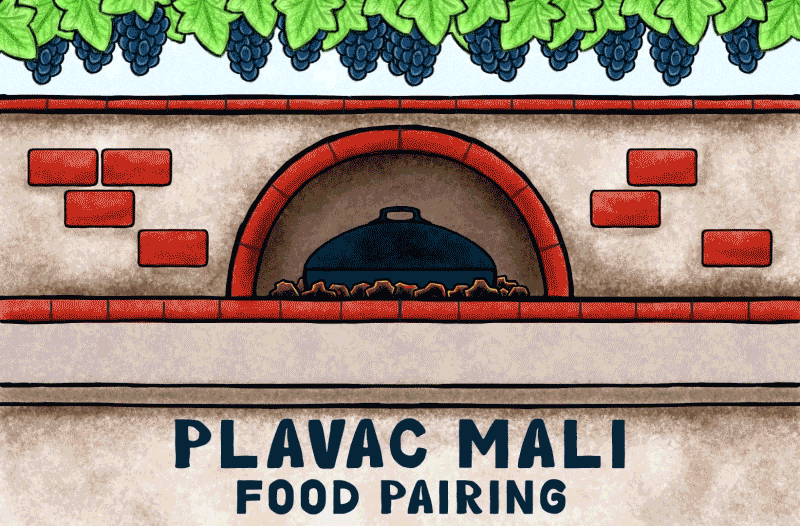 Croatia has a long and diverse history of culinary traditions, which are complemented by an extensive selection of indigenous wines. One of Croatia’s most famous wines, Plavac Mali, a full-bodied and robust red native to Croatia’s Dalmatian coast, is highly acclaimed for its distinctive character and rich flavor profile. It pairs perfectly with traditional Croatian cuisine and is especially well-suited to Dalmatian dishes. In this in-depth exploration, we will delve into the culinary world to identify and give you the recipes for the foods that complement Plavac Mali perfectly, ranging from rich international dishes to hearty traditional dishes of the Adriatic coast and Dalmatian region.
Croatia has a long and diverse history of culinary traditions, which are complemented by an extensive selection of indigenous wines. One of Croatia’s most famous wines, Plavac Mali, a full-bodied and robust red native to Croatia’s Dalmatian coast, is highly acclaimed for its distinctive character and rich flavor profile. It pairs perfectly with traditional Croatian cuisine and is especially well-suited to Dalmatian dishes. In this in-depth exploration, we will delve into the culinary world to identify and give you the recipes for the foods that complement Plavac Mali perfectly, ranging from rich international dishes to hearty traditional dishes of the Adriatic coast and Dalmatian region.
Introduction to Plavac Mali
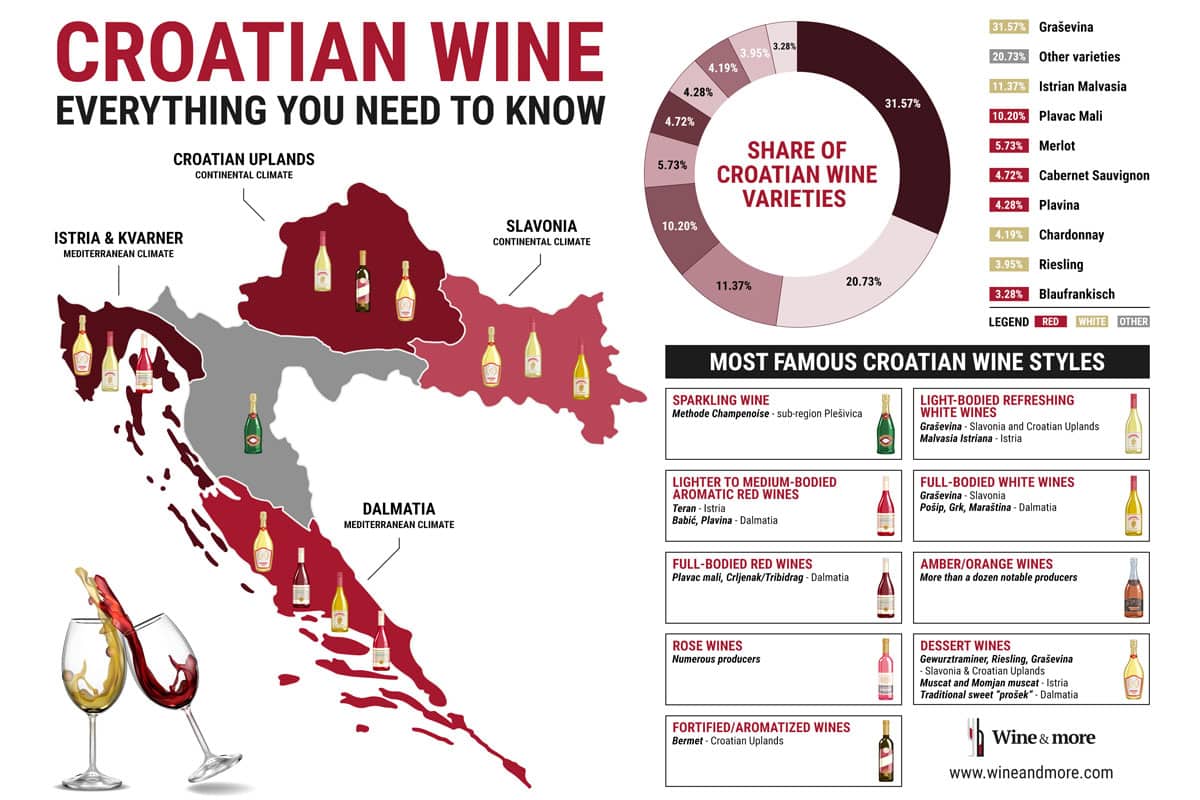
If you’re looking to expand your wine palate, trying a Croatian wine can be a great way to do it. Specifically, Plavac Mali is an ideal choice for newcomers to Croatian wines.
This grape variety is one of the most famous Croatian red wines, indigenous to the Dalmatia wine region of southern Croatia. The region’s unique climate and soil conditions produce wines with distinct flavors and aromas, including those made from Plavac Mali grapes.
Plavac Mali aromatic profile
Plavac Mali wines can come in different styles. They can be fruity reds with medium body and moderate acidity, featuring aromas of sour cherry, red plum, licorice, and sweet spices.
On the other hand, some Plavac wines from the hottest areas like the protected geographical appellation of Dingač on Pelješac Peninsula are thick, powerful, chewy, and rich in dark berry aromas such as blackberry, blueberry, or plum jam. They can also open up aromas of dried figs, carob, raisins, and sweet spices.
Oak-aged Plavac Mali wines tend to have more pronounced aromas of leather, cedar, baked fruit, and sweet spices. These wines are usually medium to full-bodied, with higher alcohol content, with powerful yet well-integrated tannins, and moderate acidity. The finest examples will have a juicy, long-lasting finish.
This variety has recently gained more attention from winemakers and wineries, such as the renowned Stina Winery from Brač Island, exploring new techniques to keep Plavac Mali wines even richer but also vibrant and layered.
By picking top-quality grapes from seriously fascinating and extreme single vineyards such as Stipančić and Murvica, they produce labels of world-class quality.
Best Plavac Mali appellations
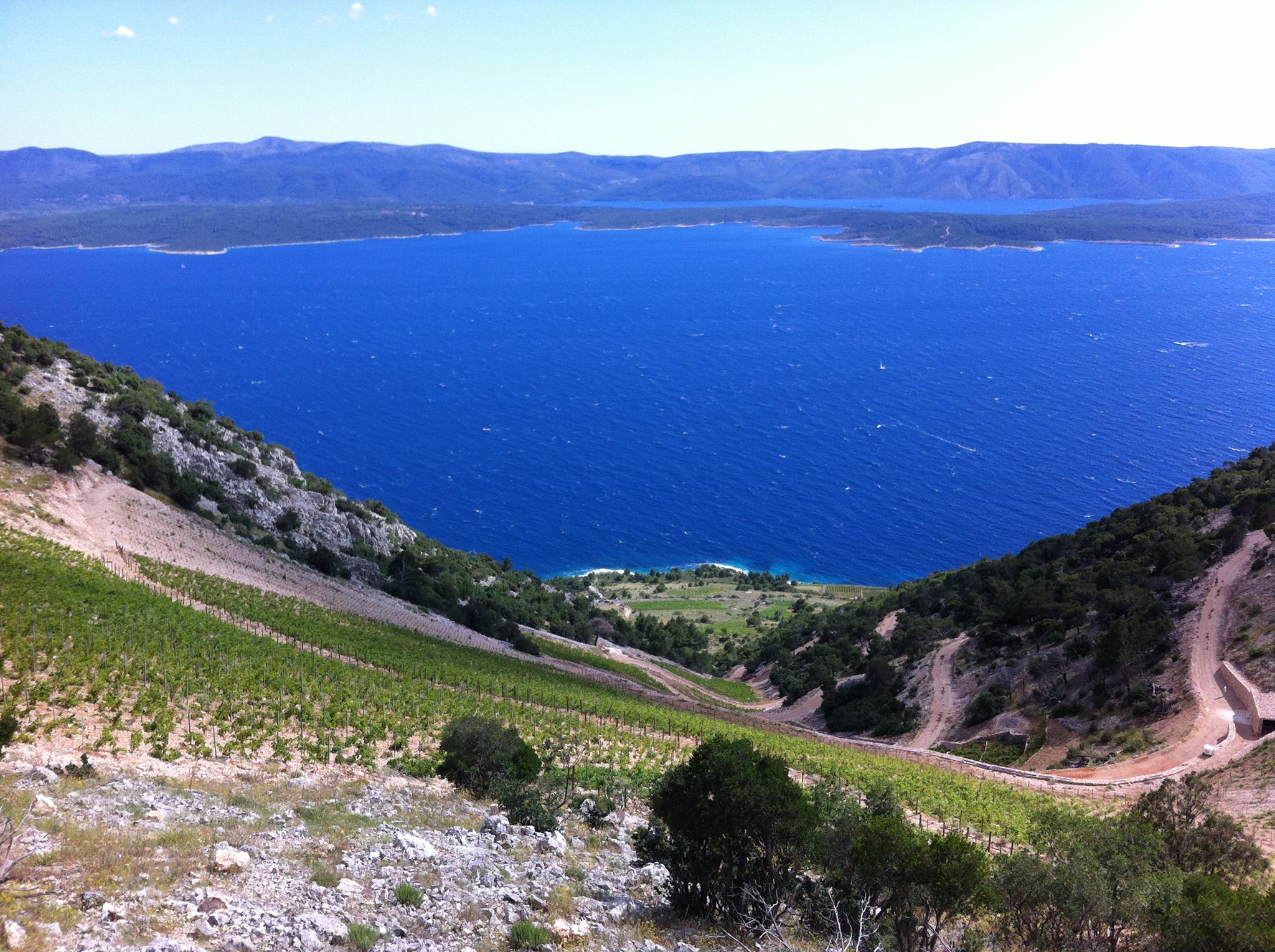
Plavac Mali is a grape variety that thrives in mainland Dalmatia, as well as on the Pelješac Peninsula and the islands of Brač, Hvar, Vis, and Korčula.
These wine subregions and appellations experience a typical Mediterranean climate, characterized by dry, warm summers and a high number of sunny days throughout the year, providing ideal conditions for producing rich, full-bodied wines.
The limestone-rich soil in the area slopes towards the Adriatic Sea, creating an ideal environment for the growth of Plavac Mali grapes. The soil is porous and absorbs rainfall quickly while preserving water in lower layers, which can be accessed by deep roots that can grow up to 10 meters long.
The hot and dry summers, along with the sea breeze, create a disease-free environment, making the region perfect for cultivating this type of grape.
However, Plavac Mali is a late-ripening and low-yielding grape variety whose grapes tend to ripen unevenly and require a lot of sunshine and warmth to achieve full maturation.
Some of the best Plavac Mali wines come from the vineyards planted on the steep slopes of the Dalmatia wine region.
Sloped vineyards provide triple insolation:
- an intense mix of direct sunlight, intensified due to limited rainfall,
- sea-reflected sun rays from a nearby coastline and vineyards on 45° inclined slopes,
- plus additional light reflection from white rock surfaces beneath the vines!
The most famous wine appellations known for outstanding Plavac Mali wines are:
- Dingač on Pelješac Peninsula,
- Postup on Pelješac Peninsula,
- Ivan Dolac on Hvar Island
- Sveta Nedilja on Hvar Island,
- Murvica on Brač Island,
- Stipančić on Brač Island,
- Komarna wine subregion,
Plavac Mali is highly valued for its use in producing one of the country’s most renowned and cherished dessert wines.
Prošek, a highly esteemed traditional dessert wine, is often produced using specially dried clusters of ripened Plavac Mali grapes. This wine is typically reserved for special occasions and enjoyed as an apéritif or a dessert wine.
What food goes best with Plavac Mali?
- Mature cheeses: Aged cheeses, like Parmesan and Pecorino, provide a salty and savory counterpoint to Plavac Mali’s robust fruitiness, creating a harmonious balance. The combination accentuates the wine’s depth while offering a delightful textural contrast.
- Duck confit: The tender, flavorful meat of duck confit harmonizes beautifully with the wine’s bold structure. The richness of the dish melds seamlessly with Plavac Mali’s intense character, creating a luxurious dining experience.
- Grilled meats: Plavac Mali’s robust character pairs exceptionally well with grilled meats, such as lamb chops and steak, enhancing the savory flavors and providing a delightful contrast to the charred notes.
- Game meats: Plavac Mali’s bold tannins complement the rich, earthy flavors of game meats such as venison and wild boar, resulting in a well-rounded and satisfying pairing.
- Grilled lamb chops: Plavac Mali’s bold tannins and robust flavors find a perfect match in succulent, grilled lamb chops. The charred, smoky notes from the grill enhance the wine’s complexity, while the tender meat balances its richness.
- Herb-infused roasted vegetables: Roasted vegetables like bell peppers, eggplants, and zucchini, infused with aromatic herbs like thyme and rosemary, create a colorful and flavorful medley. The earthy, herbaceous notes complement the wine’s spice elements, enhancing its overall aromatic profile. Plavac Mali pairs wonderfully with dishes infused with herbs as the herbal notes complement the wine’s complexity and enhance its overall aromatic profile.
- Dark chocolate desserts: The bitterness of dark chocolate is balanced by the fruitiness of Plavac Mali. Whether it’s a rich chocolate cake or velvety chocolate mousse, the wine’s dark berry flavors harmonize with the decadent sweetness of the dessert, creating a delightful contrast.
Does Plavac Mali pair with seafood?
While Plavac Mali is traditionally paired with meaty dishes, the question arises: does this bold red wine have the finesse to complement the delicate flavors of seafood?
Fatty fish and red wine can make a harmonious pairing, as the richness of fat and the structure of tannins complement each other. The fat in the fish holds flavors that tannins help to unlock, simultaneously softening the tannins’ sharpness and allowing different nuances of the wine to shine.
Grilling, broiling, and pan-frying stand out as ideal methods for preparing fatty fish. As with any seafood, it’s crucial not to overcook. The fish’s natural oils retain its juiciness, but excessive cooking can impart a metallic or overly “fishy” taste to the final dish.
Plavac Mali isn’t a subtle wine, yet it pairs wonderfully with grilled dishes, particularly those with robust flavors like these fish.
Young Plavac Mali wines delight with vibrant cherry notes, while aged variations are rich in dark berry aromas such as blackberry, blueberry, or plum jam, smoke, tobacco, and dried herbs and spices that complement grilled or smoked fish exceptionally well.
What does Plavac Mali not pair well with?
While it complements many dishes exquisitely, there are certain culinary creations that fail to harmonize with its unique characteristics.
- Spicy foods: Plavac Mali’s bold tannins clash with the heat of spicy dishes, overpowering the palate and diminishing the flavors of both the wine and the food.
- Delicate seafood: Light and delicate seafood, such as sushi and sashimi, are easily overwhelmed by the strong tannins and intense flavors of Plavac Mali, leading to an unbalanced tasting experience.
- Citrus-based dishes: Plavac Mali’s intricate flavors are often overshadowed by the acidity in citrus-based dishes, resulting in a clash rather than a harmonious pairing.
- Creamy sauces: Creamy sauces, like Alfredo or béchamel, tend to coat the palate, making it difficult to appreciate the nuances of Plavac Mali. The wine’s complexity is lost amidst the texture of the sauce.
- Spicy indian cuisine: The intricate spices and heat in Indian cuisine often clash with the bold structure of Plavac Mali, creating a discordant tasting experience.
- Light, fresh, and creamy cheeses: Plavac Mali’s intense flavors overpower the subtlety of light and creamy cheeses, diminishing the cheese’s contribution to the pairing and overwhelming the palate.
Tips for perfect food and Plavac Mali pairing
- Local is best: Opt for Plavac Mali wines from the mentioned Croatian wine subregions to enhance the authenticity of the experience.
- Balance is key: Match lighter and fresher Plavac Mali wines with lighter dishes and bolder Plavac Mali wines with hearty meals for a harmonious pairing.
- Consider regional variations: Croatian cuisine and wine vary by region. Explore local specialties (in this case, Dalmatian ones) to find the best pairings.
- Serve it right: When it comes to serving Plavac Mali, the temperature of the wine is crucial. To fully experience the richness and complexity of Plavac Mali’s flavors, it is recommended to serve it at around 16°C. During warmer months, achieving this temperature can be challenging, so a brief period of chilling in the wine cooler or refrigerator before serving is advisable. Additionally, don’t forget to let wines like Plavac Mali breathe. These wines benefit from exposure to air, so be sure to decant them about an hour before serving, allowing the wine to open up and reach its full potential.
- Experiment and enjoy: Don’t be afraid to experiment with your pairings. Everyone’s palate is different, so trust your gourmet intuition and taste buds. 🙂
Plavac Mali food pairing recipes
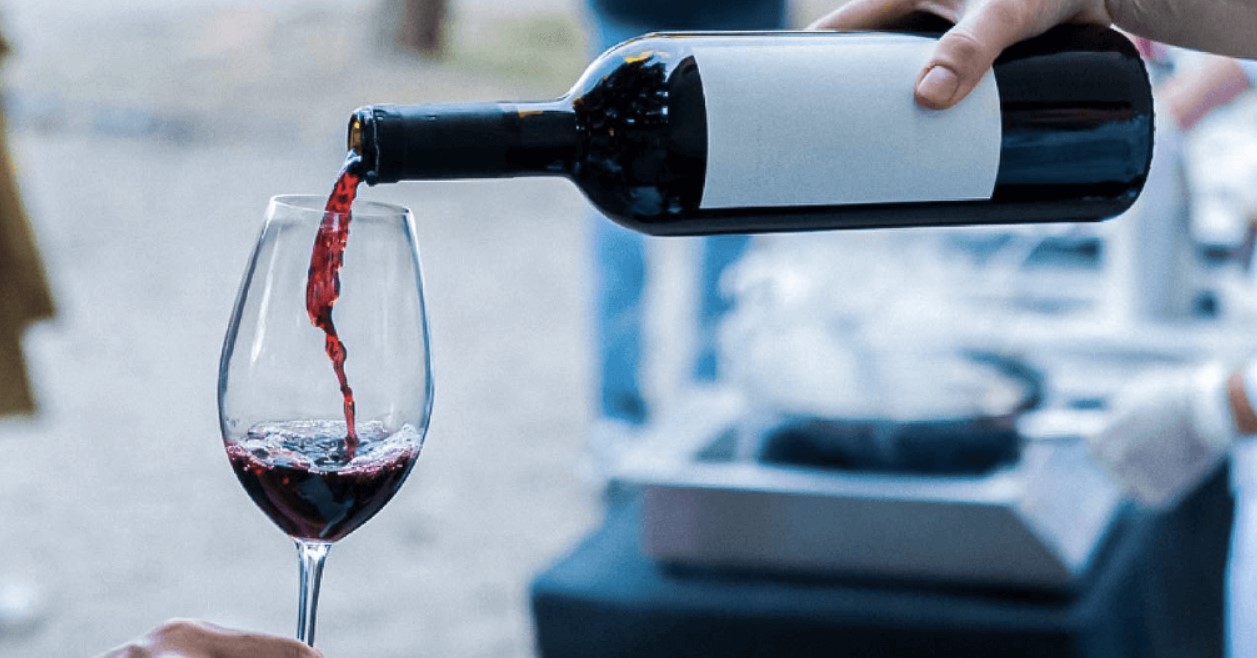
Plavac Mali is a wine deeply rooted in the history and traditions of the Dalmatian region. The grapes used to make this wine are grown in a unique microclimate with hot summers, cool sea breezes, and mild winters, resulting in a wine full of character and complexity.
If you’re wondering what to pair with Plavac Mali, the answer is pretty much simple. Its versatility makes it an excellent accompaniment to a wide range of cuisines. However, for an authentic experience, we recommend pairing Plavac Mali with traditional Dalmatian dishes.
The cuisine of the region is well-known for its fresh seafood, grilled meats, and flavorful vegetables. These dishes are typically seasoned with a blend of Mediterranean herbs and spices that perfectly complement the full-bodied taste of the wine.
For instance, Plavac Mali pairs perfectly with pašticada, a delicious veal sauce made with tomatoes, dry plums, red wine, herbs, and spices, and served with homemade gnocchi.
It goes well with beef stew, grilled lamb, or lamb under the bell. If you’re planning to have some barbecue, Plavac Mali’s rustic nature makes it a perfect match for barbecued ribs or smoked brisket, bringing out the wine’s robust flavors.
Other interesting pairings include experimenting with the original Paella Valenciana dishes that involves various different kind of meat.
If you’re a seafood lover, Plavac Mali is an excellent choice with oily fish dishes and pairs perfectly with a grilled tuna steak.
For a more straightforward pairing, Plavac Mali is fantastic with dark chocolate desserts, hard cheeses, and charcuterie with bold flavors.
Let’s uncover some of the recipes for perfect food pairings with Plavac Mali.
Herb and Spice-Rubbed Grilled Tuna Steak with Plavac Mali pairing
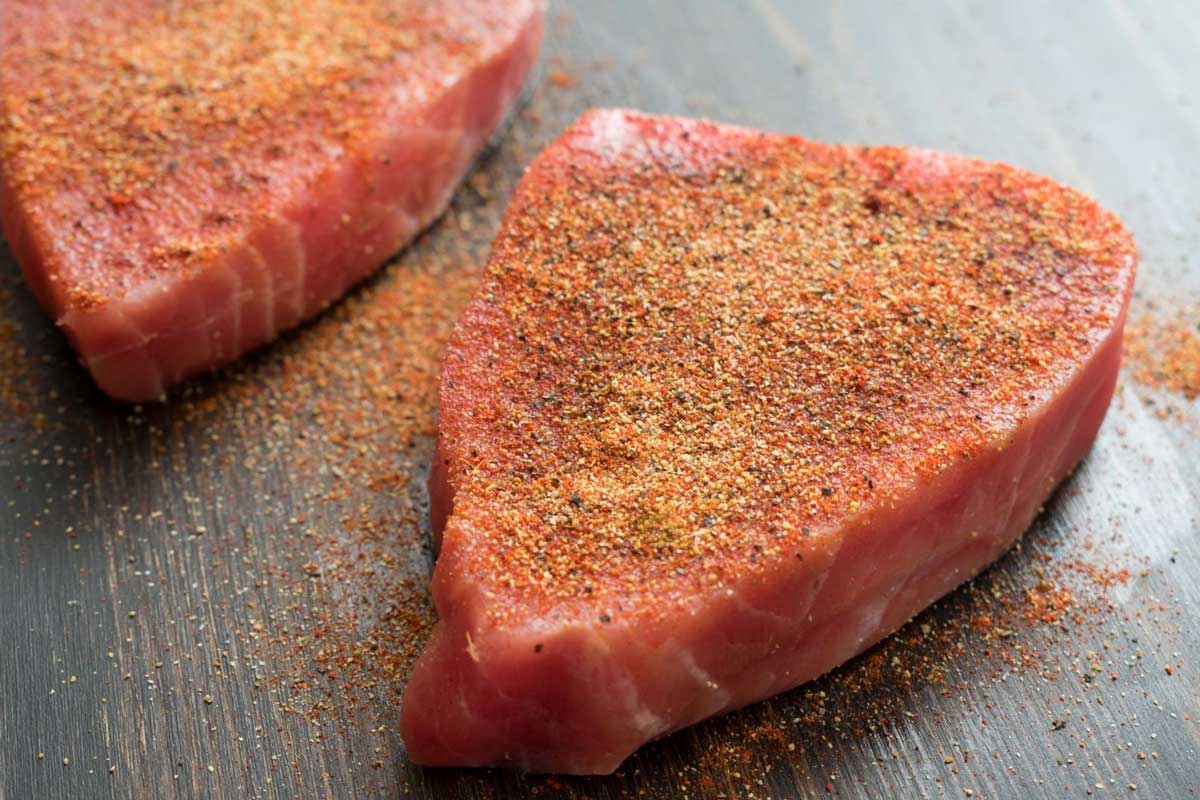
Here’s why it’s a perfect match:
- The herb and spice rub on the tuna complements the complex fruit and spice notes of Plavac mali, enhancing the overall taste experience.
- Herbs like add an aromatic element. These herbal notes can find resonance with certain red wines, such as Plavac Mali, that also feature herbal or earthy aromas, enhancing the overall aromatic experience.
- Red wines, especially those with moderate tannins, can complement the texture of the tuna. Tannins, which are compounds found in grape skins, seeds, and stems, can soften the protein in the fish, making it taste even more tender. This interplay of textures can be very pleasing to the palate.
- The combination of the tuna’s fresh, delicate taste and the herb and spice rub’s complexity makes for an intriguing pairing with the particular wine’s layered flavour profile.
Recipe
Here is the recipe:
Ingredients:
- 2 tuna steaks (about 200-250g each)
- 2 tablespoons olive oil
- 2 cloves of garlic, minced
- 1 teaspoon ground coriander
- 1 teaspoon ground cumin
- 1/2 teaspoon sweet paprika
- 1/2 teaspoon dried thyme
- Salt and black pepper, to taste
- Fresh parsley leaves for garnish (optional)
Instructions:
- In a small bowl, combine the olive oil, minced garlic, ground coriander, ground cumin, sweet paprika, dried thyme, salt, and black pepper to create a spice mixture.
- Rub the spice mixture onto both sides of the tuna steaks, ensuring they are well-coated. You can let them sit for a few minutes to absorb the flavours, but it’s not necessary to marinate for an extended period.
- Preheat your grill to high heat.
- Once the grill is hot, place the spiced tuna steaks on it. Grill for about 2 minutes on each side for medium-rare. Adjust the cooking time to your desired level of doneness. Be careful not to overcook the tuna.
- Remove the tuna from the grill and let it rest for a couple of minutes.
- Optionally, garnish the tuna steaks with fresh parsley leaves for a touch of freshness.
- Serve your spiced grilled tuna steaks hot with your choice of side dishes, such as roasted vegetables, a couscous salad, or garlic mashed potatoes.
Beef stew (Pašticada) with Plavac Mali pairing
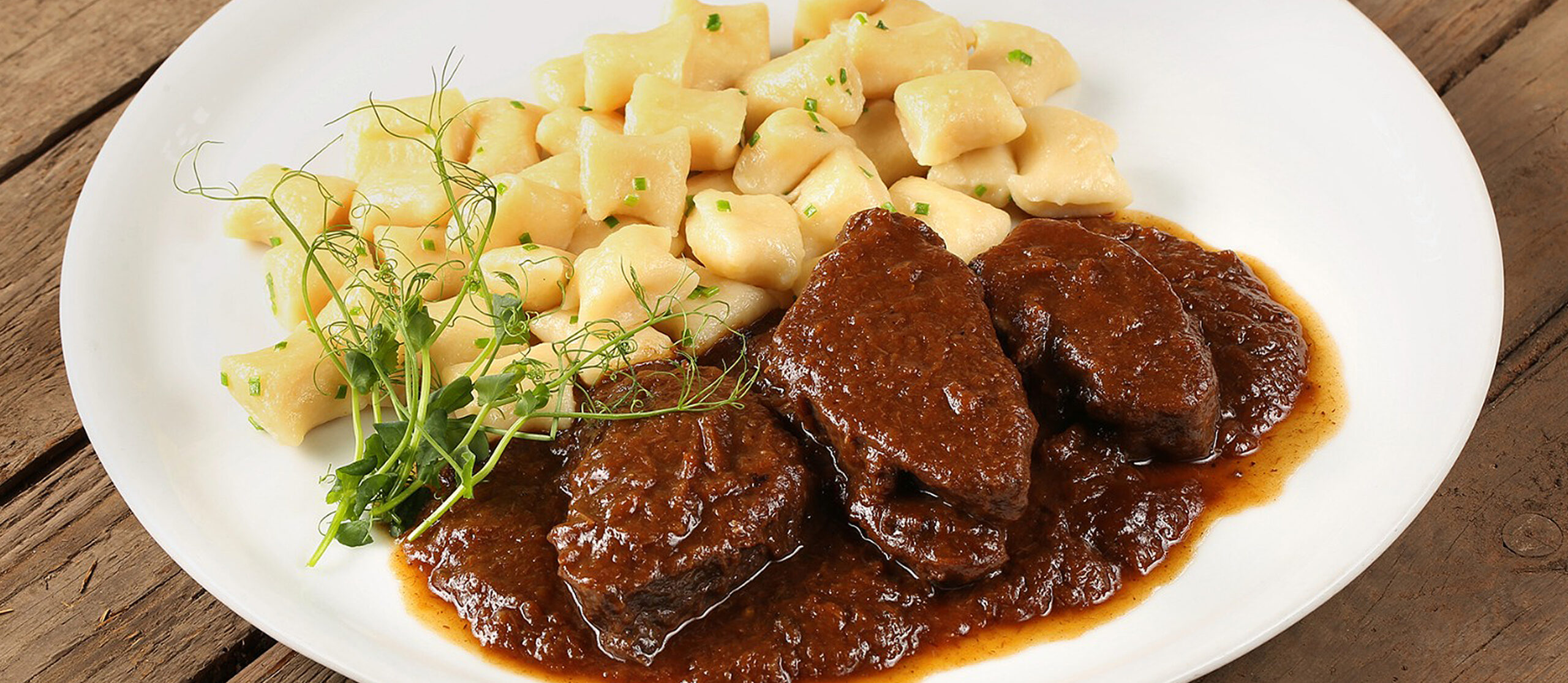
Dalmatinska pašticada, a hearty stew dish originating from the Dalmatian region, is a delicacy that is renowned for its complex flavors and textures.
This hearty and delicious dish is made with tender beef, vegetables, and spices that are slow-cooked for hours to create a rich and complex flavor. The result is a mouth-watering delicacy.
To complement the rich and savory flavors of Dalmatinska pašticada, it is best paired with Stina Plavac Mali Stipančić, a unique single-vineyard Plavac made from grapes grown in a stunning extreme sloped vineyard on Brač Island.
The wine has a rich bouquet with concentrated aromas of dark fruit and spicy notes. Its extractive and full-bodied taste is complemented by ripe tannins, surprising freshness, and a long finish, making it a perfect match for the hearty and complex flavors of Dalmatinska pašticada.
With its exceptional taste and quality, Stina Plavac Mali Stipancic represents the very pinnacle of Croatian Plavac Mali wine.
Recipe
Here is the recipe:
Ingredients
Servings: 6 persons
For pašticada
- 2 kg (4.4 lbs) of beef chuck
- 50 g smoked/dried bacon (1.7 oz)
- 200 g onions (7 oz)
- 150 g parsley root (5.3 oz)
- 150 g carrot (5.3 oz)
- 50 g celery root (1.8 oz)
- 2 garlic cloves
- 40 g tomato paste (1.4 oz)
- 200 ml olive oil (1 cup)
- 6 dried figs
- 10 g cloves (0.35 oz)
- 10 dried plums, diced
- 6 dried figs
- 2 apples, peeled and quartered
- 300 ml red wine (1 1/4 cups)
- 2 tablespoons mustard
- 3 bay leaves
- Small bunch of thyme
- Rosemary leaves
- Salt and freshly ground black pepper
For homemade gnocchi
- 1 egg
- 175 g flour (type 550) (6.1 ounces)
- 60 g butter (4 tablespoons) cut into small cubes
- 500 g white potatoes (17.6 ounces)
- Pinch of salt
- A few drops of olive oil
Instructions
- Wash and dry the meat, then stuff it with strips of bacon. Season it well with salt, coat it with mustard and oil, and let it marinate with the sliced vegetables for at least 12 hours or overnight.
- Sear the meat quickly on all sides in hot oil. Remove it from the pot and sauté the sliced onion and garlic along with chopped vegetables in the same oil. Return the meat to the pot and simmer it covered for about 2 hours, occasionally adding small amounts of a mixture of water and wine.
- When the meat is halfway tender, add the diluted tomato paste, washed prunes, figs, and quartered apple. Towards the end of cooking, add bay leaf, rosemary, thyme, pepper, and a bit more salt if needed.
- Take out the meat, slice it, and return it to the vegetable sauce, which you have previously strained. Simmer the sauce with the meat for a short while.
- For the gnocchi, peel the potatoes and mash them while they are still hot. Add flour, butter, egg, and salt. Knead the dough, divide it into two to three parts, shape each part into a log, and cut pieces of equal size. Cook the gnocchi in boiling salted water for about 10 minutes, then drain. Serve the stew with homemade gnocchi.
Lamb under the Bell (Janjetina ispod Peke) with Plavac Mali pairing
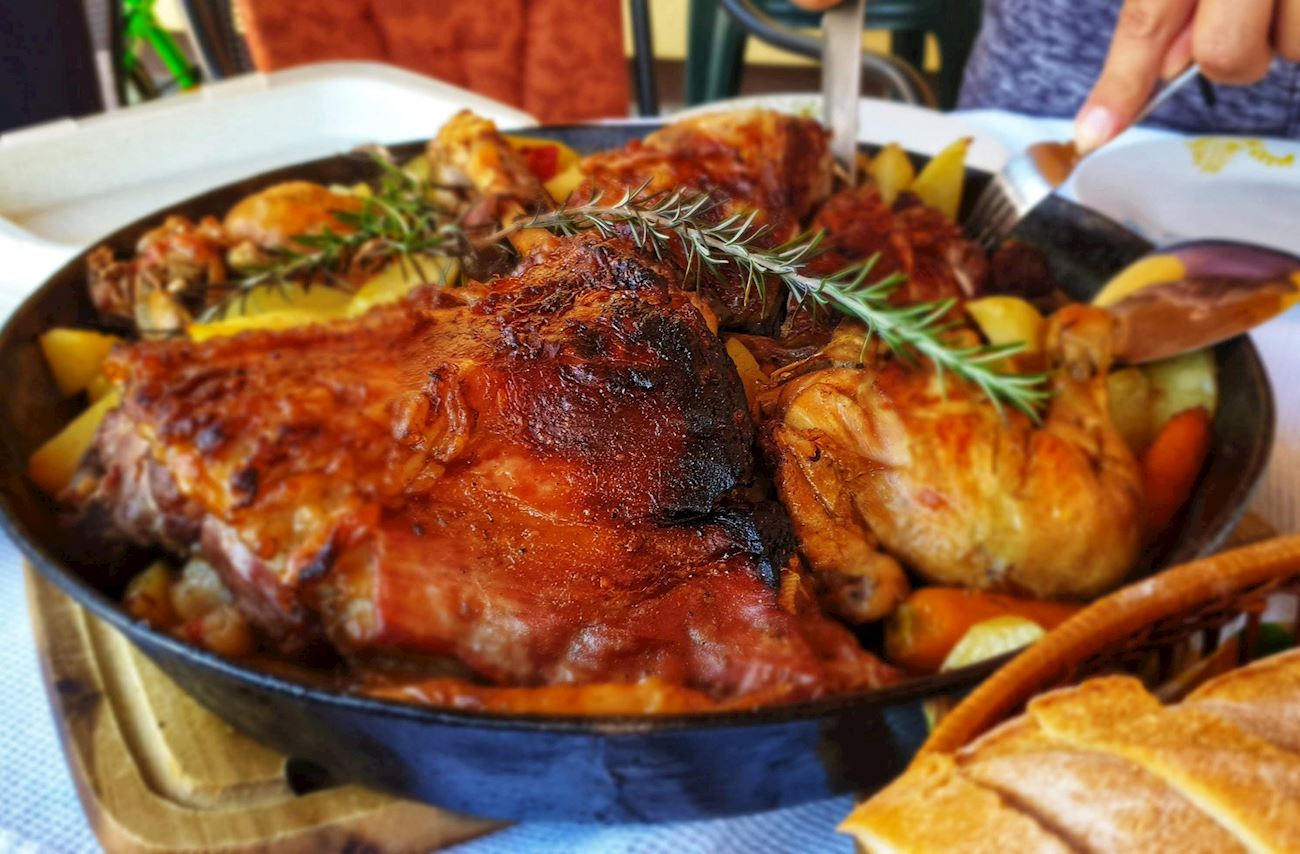
Lamb under the bell or Janjetina ispod peke is a traditional Croatian dish that involves slow-cooking meat and vegetables. The dish is prepared by roasting lamb under a bell that is covered with hot embers.
This method of cooking produces meat that is tender, flavorful, and has crispy skin, along with perfectly roasted vegetables. To enhance the dining experience, Plavac Mali Majstor, pairs well with the savory goodness of the dish.
The Plavac Mali Majstor has intense aromas of red and black fruit, with well-balanced notes of wood obtained during maturation. The lamb’s smoky and savory flavors are complemented by the smooth tannins of the wine, which also help to soften the texture and enhance the overall dish.
Recipe
Here is the recipe:
Ingredients
- 2 ½ kilograms of lamb (front or rear quarter) (4.4 Ibs)
- 1 kilogram of potatoes (2.2 Ibs)
- 2 heads of red onions
- 4 cloves of garlic
- 4 medium-sized carrots
- 2 bell peppers fresh sage and rosemary
- olive oil
- 200 ml of dry white wine (1 cup)
- coarse sea salt
- freshly ground black pepper.
Instructions
- Firstly, you’ll need to cut the lamb quarter into larger, more manageable pieces. The key to this dish is selecting the freshest, young lamb that isn’t too fatty. Once you have the lamb, generously rub coarse sea salt and freshly ground pepper all over the lamb pieces, ensuring that every inch is coated with the delicious seasoning.
- Next, brush the meat with a good-quality olive oil, which will impart a subtle yet distinct flavor to the lamb. Allow the lamb to marinate in the oil and seasoning while you prepare the vegetables, letting the flavors meld together for a mouth-watering taste sensation.
- Peel and chop the potatoes into large pieces. Clean the remaining vegetables and chop them coarsely. Place all the chopped vegetables in a large bowl, season with salt and pepper, and drizzle with olive oil. Optionally, you can add a bit of ground sweet paprika.
- Take a large deep baking dish and brush it with olive oil. Place the vegetables first, followed by the meat. Pour wine over everything, then place the dish with the meat and vegetables onto the previously heated surface where you prepared the fire for roasting. Cover it with the roasting bell, which you’ve heated above the fire for some time.
- Cover the bell with a thin layer of ash and place the prepared ember on top. Roast the dish for approximately 100-120 minutes, depending on how well-done you want the vegetables and lamb to be.
- Afterward, spread the embers, lift the lid, and let the meat “rest” for 5-10 minutes before serving. Serve the lamb cooked under the bell with homemade bread, green salad, and spring onions.
Slow-cooked BBQ pork ribs with Plavac Mali pairing
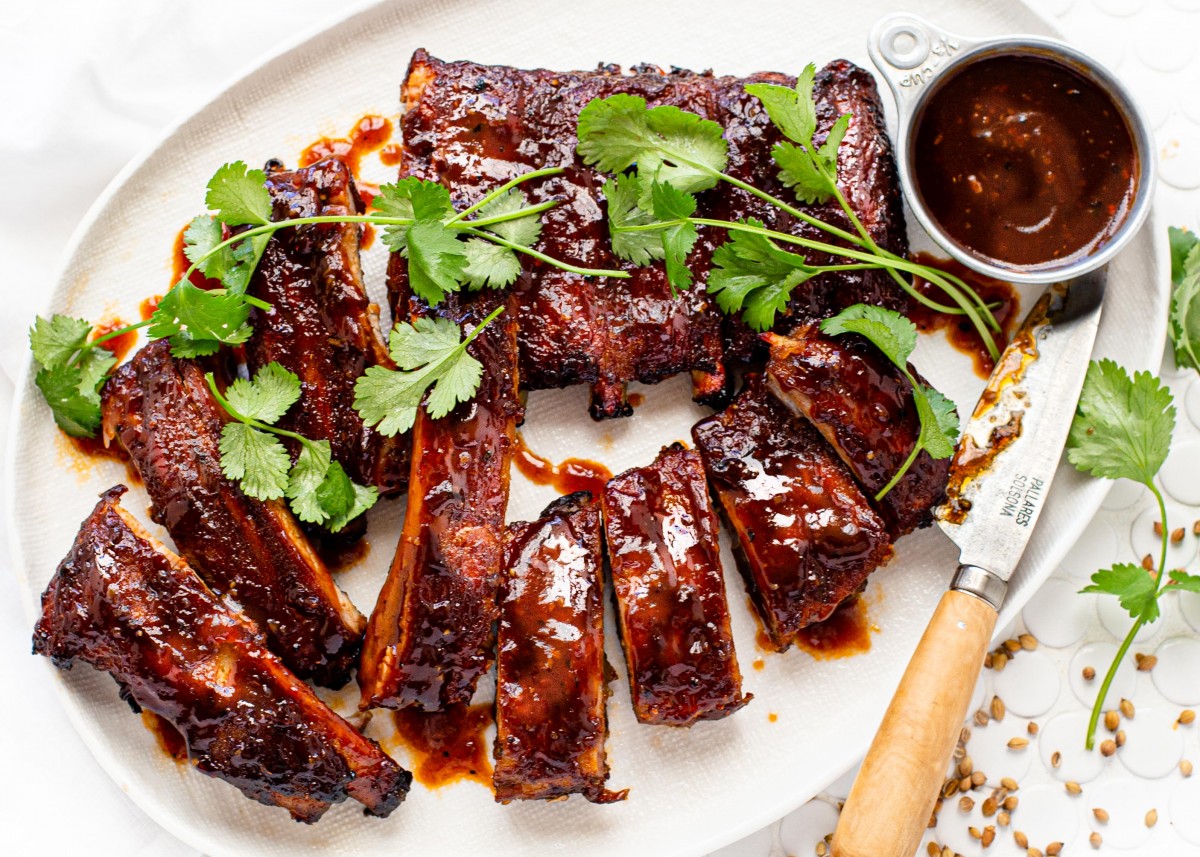
Barbequed pork ribs are a beloved dish in the world of barbecue. Typically prepared from pork cuts, these ribs are marinated with a flavorful mixture of spices, sauces, and seasonings before being slow-cooked, either on a grill or in an oven, until they reach a perfect tenderness.
The process of barbequing ribs involves smoking or grilling them over low, indirect heat, allowing the meat to absorb the smoky flavors while becoming incredibly tender and pair perfectly with Stina Plavac Mali Barrique whose intense and fresh fruitiness and excellently dosed acidity intertwine with barbeque sauces.
Some recipes call for a pre-cooking process, like boiling or baking, to ensure the ribs are thoroughly cooked before hitting the grill.
The ribs can be coated with various types of barbeque sauces, ranging from tangy and sweet to spicy and smoky, enhancing the overall taste.
Recipe
Here is the recipe:
Ingredients
- 2 kg pork ribs (4.4 Ibs)
For the marinade:
- 2 teaspoons (0.3 ounces) garlic powder
- 2 teaspoons onion powder (0.3 ounces)
- 2 teaspoons smoked paprika (0.3 ounces)
- 2 teaspoons salt (0.3 ounces)
- 1 teaspoon coarsely ground black pepper
- 1/2 teaspoon cumin (0.25 ounce)
- 1 teaspoon cayenne pepper (0.1 ounce)
- 500 ml vegetable broth (17 oz)
For the BBQ sauce:
- 500 ml BBQ sauce (2 cups)
- 3 teaspoons garlic powder (0.5 ounces)
- 2 teaspoons Worcestershire sauce (0.3 ounces)
- 2 tablespoons honey (0.3 ounces)
- 1 tablespoon lemon juice (0.1 ounce)
- 1 teaspoon brown sugar (0.1 ounce)
- 1 teaspoon ground black pepper (0.1 ounce)
- 1 teaspoon salt (0.1 ounce)
Instruction
- Remove the membrane/skin from the back of the ribs by holding one end with one hand and pulling the membrane off with the other hand. Marinate the ribs by mixing all the spices and evenly sprinkling them over the ribs.
- Place the marinated ribs in a deep baking dish and carefully pour the vegetable broth over them to prevent the marinade from coming off. Then, cover the ribs with parchment paper and aluminum foil.
- During cooking, the broth will evaporate and give the ribs, in addition to flavor, the final effect of easily separating the meat from the bones.
- Bake the ribs at 180°C or 356°F for 2 hours. While the ribs are baking, there’s enough time to make a great BBQ sauce.
- Simmer all the ingredients together over medium heat, stirring until it boils. Reduce the heat and let it simmer, stirring occasionally, for ten minutes.
- When the ribs are done, remove the foil and parchment paper, coat the ribs with BBQ sauce.
- Increase the oven temperature to 240°C or 464°F, return the sauced ribs to the oven and bake for 5-7 minutes.
- Serve with grilled corn and extra BBQ sauce.
Conclusion
Plavac Mali is a wine that captures the essence of the Dalmatian terroir with unparalleled precision.
This wine is a perfect companion for any authentic Dalmatian dish, as it perfectly complements the traditional stew and meat dishes. However, it also pairs exceptionally well with international cuisine, allowing you to explore and experiment with new and exciting flavor combinations.
Don’t hesitate to try out the suggested combinations and let us know your thoughts on how the flavors and textures of the wine complemented the dishes. We’d love to hear your feedback! 😉



















